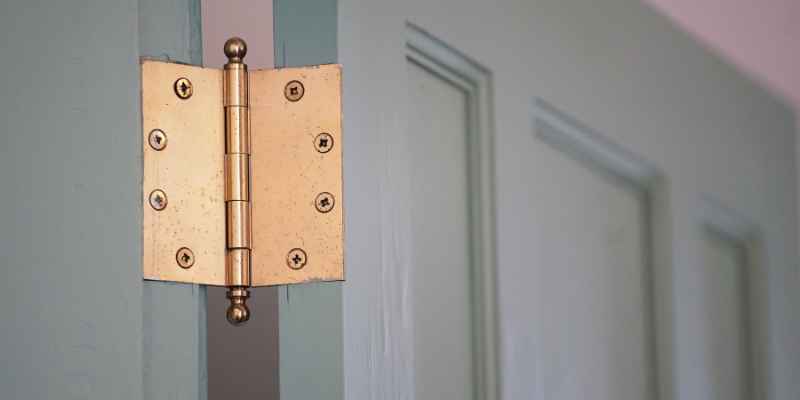To hinge two pieces of plywood, align the edges and mark where the hinge will go. Secure the hinge with screws, ensuring it allows smooth movement.
Hinging plywood is a practical solution for various DIY projects, such as creating foldable furniture or hidden compartments. Properly hinged plywood can enhance functionality while maintaining a sleek appearance. With the right tools and techniques, you can easily create a strong and durable joint.
This process involves selecting the right hinges, ensuring precise alignment, and using appropriate fasteners. Whether you’re a seasoned woodworker or a beginner, understanding how to hinge plywood opens up a world of creative possibilities. This guide will walk you through the essential steps to achieve a professional finish in your project.
Introduction To Plywood Hinging
Plywood is a versatile material made from thin layers of wood. These layers are glued together, creating strength and durability. Understanding the properties of plywood helps in effective hinging.
Thickness varies in plywood, affecting its flexibility. Thicker plywood offers more strength, while thinner sheets are easier to bend. The wood grain direction also matters. Aligning hinges with the grain enhances strength.
Proper hinging is crucial. It ensures smooth movement and stability. Using the right hinge type adds to durability. A well-hinged plywood piece will last longer and perform better.
| Plywood Property | Importance |
|---|---|
| Thickness | Affects strength and flexibility |
| Grain Direction | Enhances strength when aligned |
| Hinge Type | Ensures durability and smooth movement |
Tools And Materials Needed
To hinge two pieces of plywood, gather the right tools and materials. Here is a list of essential tools:
- Hinges – Choose the right type for your project.
- Screws – Ensure they match your hinges.
- Drill – Use for making holes.
- Screwdriver – Needed to tighten screws.
- Measuring tape – For accurate measurements.
- Level – To keep everything straight.
- Clamps – Hold plywood pieces in place.
Choosing the right hinges is important. Consider the weight and size of the plywood. Use butt hinges for a clean look. Piano hinges work well for larger pieces. Always check that the hinges fit properly.

Preparation Steps
Start by gathering your tools. You need a measuring tape, pencil, and square. Measure the plywood carefully. Mark the spots where the hinge will go. Use a square to ensure straight lines.
For cutting plywood accurately, choose a sharp saw. A circular saw works best for straight cuts. Always wear safety goggles while cutting. Cut along the marked lines for a clean edge.
Check your cuts for any rough edges. Sand them down to make them smooth. This ensures a better fit for the hinges.
Types Of Hinges Suitable For Plywood
Butt hinges are common for plywood projects. They are easy to install and provide strong support. These hinges work well for doors and cabinets. They come in various sizes and finishes.
Piano hinges are long and provide even support along the edge. They are perfect for larger pieces of plywood. Their continuous design helps distribute weight evenly. This feature makes them ideal for foldable tables or lids.
| Type of Hinge | Best For |
|---|---|
| Butt Hinges | Doors, cabinets |
| Piano Hinges | Large plywood pieces |
Attaching Hinges To Plywood
Start by marking the hinge location on both pieces of plywood. Use a pencil for precision. Make sure the hinges are aligned properly to allow smooth movement. Next, drill pilot holes at the marked spots. This step helps prevent the wood from splitting. Choose a drill bit that matches the screw size.
Now it’s time to secure the hinges with screws. Use a screwdriver to insert the screws into the pilot holes. Tighten them until they are firm but not too tight. Over-tightening can damage the plywood. Check the hinge’s functionality by opening and closing it. Ensure it moves freely without any obstruction.
Aligning The Plywood Pieces
Align the plywood pieces carefully for proper hinging. Use a straight edge to check alignment. Make sure both pieces are level and flush. This ensures a smooth movement when opening and closing.
To ensure smooth movement, check the hinges. Choose the right hinge type for your project. Install hinges on the edge of the plywood. Leave enough space for the hinge to work freely.
Adjust for gaps and overlaps. Use a sander to smooth out any rough edges. Measure gaps to ensure they are even. Make small adjustments as needed for the best fit.
Finishing Touches
Start by carefully sanding the edges of the plywood. Use fine-grit sandpaper for smoothness. This step helps prevent splinters. Make sure to sand in the direction of the grain.
After sanding, clean off the dust. A damp cloth works well for this. This prepares the surface for the sealant.
Next, apply a sealant or finish. Choose a product suitable for plywood. Use a brush or roller for even application. Allow it to dry completely.
Apply a second coat if needed. This enhances durability and appearance. Always follow the manufacturer’s instructions for best results.
Maintenance And Care
Regular inspection of the hinges is very important. Check for any signs of rust or damage. If the hinges look worn, consider replacing them. This helps keep the plywood secure and functional.
Lubrication keeps the hinges moving smoothly. Use a suitable lubricant to prevent squeaking. Clean the hinges regularly to remove dirt and grime. A clean hinge lasts longer and works better.
Troubleshooting Common Issues
Misalignment of plywood pieces is a common problem. To fix this issue, check the hinges first. Ensure they are installed correctly. Adjust the position of the hinges as needed. Tighten any loose screws for better alignment.
Dealing with stiffness or squeaking? Apply a small amount of lubricant to the hinges. This helps them move smoothly. If squeaking persists, check for debris. Clean the area around the hinges thoroughly.
Sometimes, wood may warp. This can cause stiffness. To solve this, place weights on the plywood. This can help straighten it over time. Regular maintenance will keep your plywood functioning well.
Creative Applications
Hinging two pieces of plywood opens up many creative possibilities. DIY furniture projects can be both fun and functional. Consider making a foldable table. This table can save space and be easily stored.
Another idea is a hidden storage bench. It provides seating and keeps items out of sight. Use hinges to create a flip-top design for easy access.
Try creating a playroom divider. It can separate spaces and add a fun touch. Using plywood with a hinge allows for easy movement.
Building a plywood cabinet with hinged doors is also practical. It adds style and storage to any room. Each of these projects showcases the versatility of hinged plywood.

Frequently Asked Questions
How Do You Hinge Plywood Properly?
To hinge plywood properly, start by selecting the right type of hinge. Use a butt hinge for a clean look. Mark the hinge placement accurately on both pieces. Drill pilot holes to avoid splitting the wood. Finally, attach the hinge securely, ensuring smooth movement.
What Tools Are Needed For Hinging Plywood?
You will need a few essential tools for hinging plywood. A drill, screwdriver, and measuring tape are crucial. Additionally, a chisel may be necessary for recessing the hinge. Always have clamps handy to stabilize the pieces while working. This will ensure accuracy and ease during the installation.
Can I Use Any Hinge For Plywood?
Not all hinges are suitable for plywood. It’s best to use butt hinges or piano hinges for this material. These provide strength and stability without adding bulk. Ensure the hinge is rated for the weight of the plywood. This will ensure durability and proper function over time.
How To Choose The Right Hinge Size?
Choosing the right hinge size depends on the plywood thickness and weight. For standard thickness, a hinge width of 1. 5 to 2 inches is ideal. Ensure the hinge can support the weight of the plywood. Consider the door’s height and frequency of use for optimal performance.
Conclusion
Hinging two pieces of plywood can transform your projects. With the right tools and techniques, it becomes a straightforward task. Remember to measure accurately and choose quality hinges for durability. This simple skill opens up endless possibilities for your woodworking creations.
Start experimenting today and elevate your craftsmanship!

